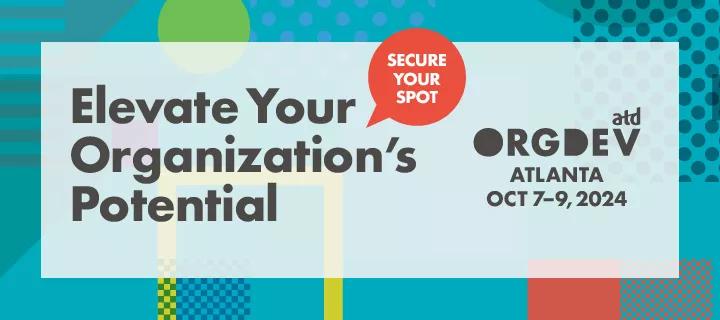ATD Blog
When Things Go Bad: How Strategic OD Can Turn Big Disruption Into a Big Advantage
As you dive into the next disruption, two ideas may help you shift it into a strategic OD leap.
Wed Aug 28 2024

Your client is facing disruptions like never before. Something that you and your client are doing together may even make it worse. Can this help you make a bigger difference in the world?
Take advantage of it!
Anyone’s impact on an organization, and its impact on many more people, can grow strategically if:
We look beyond the “out-of-control” situation for its larger strategic leverage.
We connect a few people who are willing to try with us and to learn from and build upon the failures.
Many wild, unpredictable disruptions are opening the door for strategic organization development (OD): polarized politics, generative AI, climate change … and something in your current work.
With these two clients and many others, misfires helped create much larger, strategic OD outcomes. People can certainly argue about why each of these worked. What do you think?
“Our School Needs More Space”
The small school was growing, but its owner had no more space. Worse, another school with the same owner (a prestigious university) also needed the same space. I was hired to facilitate strategic planning.
The board and staff leaders liked my idea of “stretching our thinking” by engaging broader stakeholders. We created a small committee of people who we hoped could reach farther—in addition to the board, administrators, faculty members, parents, and students. The committee also interviewed the most respected authors in this kind of education (gifted)—who knew nothing about this school’s approach.
The committee together compiled the data effectively. It all seemed creative and valid.
We held a two-session strategic planning sequence, inviting 25 stakeholders to digest the data, draft a vision and strategy, and initiate small actions to kick it off. The authors joined—in person! A review session, four weeks later, was designed to evaluate the impact of our first actions and to continue or revise the next strategic steps.
But, we learned more than we bargained for!
Our grand idea to engage wider stakeholders did successfully engage parents—but we’d missed a certain group of parents, who were quite angry about it. They felt left out of this “inclusive” process!
Yet, when the leaders humbly apologized and asked this turned-off group to join in a Round 2, they did.
The parents also found a large space that had just become available and desperately needed a buyer—for cheap! The school took advantage of the price, the actively engaged parents, and the new location.
The school opened its new campus, doubling its space in a location near the “angry” parents. No one had considered such a strategy—not the school leaders or the creative national authors: Yet, the school has become truly regional, with campuses in strategic locations around this large metropolitan area. It was a leap from “one squeezed school” to a regional institution.
Because we drafted the strategy to evolve, we were ready to learn, even though our mistake was painful. The humility built a genuine partnership with the ignored parents.
Why did this serious test of our process lead to deeper engagement from all parties—and practical, ongoing strategic expansion?
“Our High-Tech Manufacturing Plant Just Crashed”
The plant’s amazing machine produced state-of-the art computer components. Then, it suddenly started producing unrecoverable “scrap.” In the minutes before shutdown, well over a million dollars was lost.
The top leader asked for two of us to facilitate a sudden, off-site strategic planning with all managers.
As the managers met, the supervisors back at the plant demanded that they be included. “We know what really goes on; you managers are too distant.” After heated arguments among the managers, the supervisors were invited to join.
They together came up with a consensus plan to fix this broken machine and revise the entire plant layout. Management offices were moved out of the corner into the center of the plant, for quick communication with supervisors at any time.
But, the plan backfired: Supervisors were too intimidated to meet openly with managers in front of the floor workers, and the managers hated being constantly on display.
Yet now, because the supervisors and managers had worked together under the immense pressure of the broken machine, genuine trust had been built. Their revised plan was to change the plant again—back to the way it had been for years! The managers moved back into corner offices again!
The new level of trust had a much greater payoff: A long list of customer complaints was now getting addressed effectively. Upper management in the company noticed. This plant became a star!
You, Now?
Where can you expand strategy? What’s disrupted? An overloaded team with a short deadline? Your organization’s clash about climate change? An onslaught of contradictory AI demands?
As you dive into the next disruption, two ideas may help you shift it into a strategic OD leap:
1. First hear each other: Convene a few broader strategic friends. Don’t just talk to the top executive or management team. Gather a few others who have interest and influence in the challenge. Ask each to name one key point from a favorite method of “improvement.” Write these as a short list. Give each person three dots; vote and choose “key ideas we can use here.”
2. Check in briefly with the OD Greats—ATD and Google. As you discuss the challenge, even an hour or two scanning a few OD resources may spark a larger path that you can start simply. Options:
Maybe scan Organizational Development and Change by Cummings and Worley. Check the two pages on “Evolution in Organization Development.” Or take a few minutes to see what Sorensen and Yaeger say in the chapter, “Value Added: The Strategic Partnerships of Human Resources and Organization Development.”
Be careful: This Sorensen and Yaeger book, Strategic Organization Development: Managing Change for Success, is short. You may get tricked into reading the whole thing!
If you or one of your friends has an OD book by Michael Beer, Donald Anderson, Bill Passmore, or Warner Burke, look at the Table of Contents for ideas about a strategic leap.
Maybe you can apply, in action, the ATD Talent Development Capability Model™ and “Five Phases of OD Strategy.” Quickly compare it to OD Network’s Global Competency Framework.
Google the term “Strategic Organization Development Process.” How do Accenture, IBM, Wharton, and other universities look at OD? What essentials are shared by credible OD leaders in Google?
Brief Exploration of a Few OD Sources – Then Get Moving!
Whittle the ideas from your friends and a few OD sources to fit what you face. Try something short, not a whole multi-step OD intervention process. Let this challenge strengthen your agility.
By adapting together in a real problem, you make the culture more agile and strategic. You’re ready for the next unexpected changes, as a team connected in action—and in reality.
How to Welcome Mistakes
Our mistake with one small group of parents pushed us to shift the school’s strategic process—grandly! Our “grand” revision in the high-tech plant layout was painful and wonderful. This mistake grew a level of trust that nothing else ever had.
Both cases gave the client greater, lasting, strategic results.
If you scan a few OD sources as an informal team, you may prevent your OD from getting set in stone and foster teamwork among the wider people who will shape the future. Quietly inserting strategic OD and agility into the habits and culture will ultimately save time and money.
More important, this path gets the right people learning and ready, together, for the next disruption.
Editor’s note: The two cases presented here, “The School” and “High-Tech,” are expanded as chapters in the first edition of the book by Donald Anderson, Cases and Exercises in Organization Development & Change.
You've Reached ATD Member-only Content
Become an ATD member to continue
Already a member?Sign In

